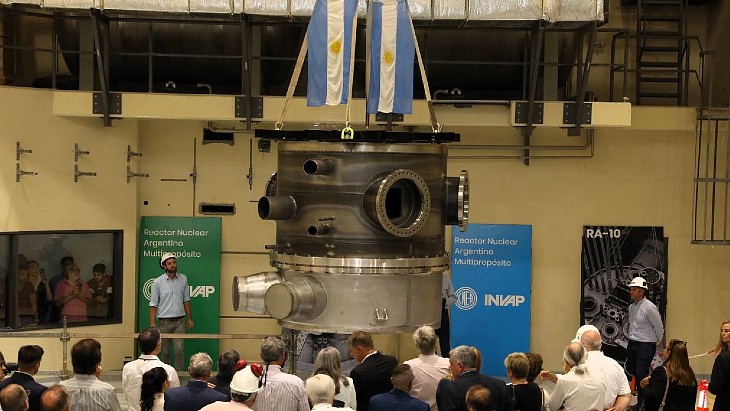Reflector tank lifted for installation in Argentina's RA-10 research reactor

It was lifted up by crane to the level of the RA-10 reactor pool ready for its installation, with the moment witnessed by visitors including Treasury Minister Carlos Guberman, together with the president of Argentina's National Atomic Energy Commission (CNEA) Adriana Serquis, staff who are working on the project and representatives of various domestic companies participating in the construction of the reactor.
RA-10 Project Manager Herman Blaumann said: "The reflector tank is a critical component ... and after its installation the stage of assembly of pool internals begins ... so we are getting closer to the start-up, which we hope can begin next year."
Once the reactor pool internals are assembled, the pool will be filled, with a target of January 2025 for pre-operational tests with the commissioning process continuing and the aim of it becoming operational in 2026.
Serquis paid tribute to the long history of nuclear expertise in Argentina, saying that knowledge, qualifications and experience had been built up over many years, adding: "That capacity that we have as a country is unique and we must not lose it."
CNEA says the RA-10 - a 30 MWt open-pool research reactor - will be used for the production of medical radioisotopes, including the capacity to cover 20% of the world demand for molybdenum: "Technetium is obtained from molybdenum, and widely used in nuclear medicine ... it will also be possible to produce other radioisotopes that are not made in the country today and that are widely used in the world, such as lutetium, which is applied to treat prostate cancer and other pathologies, as well as others for use in agriculture and the industry".
The RA-10 project was approved by the government and was officially started by CNEA in June 2010. Argentina's Nuclear Regulatory Authority granted a construction licence for RA-10 in November 2014. The civil works for the reactor began in 2016. Nuclear technology firm INVAP is involved in the design and construction of the reactor facility and related installations, playing the role of main contractor. The assembly of the RA-10 pool - which will house the core of the reactor - was completed in August 2018.
The RA-10 will replace the RA-3 reactor on the same site, a 10 MWt pool-type reactor which began operations in 1967. As well as producing radioisotopes the RA-10 will also provide new research and training opportunities and will have associated facilities such as the Argentine Neutron Beam Laboratory (LAHN) and the Laboratory for the Study of Irradiated Materials (LEMI).
_92619.jpg)

_84504.jpg)






_50521.jpg)


